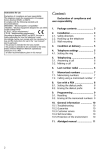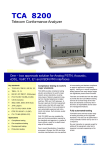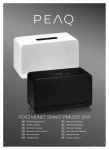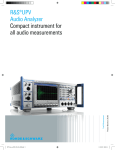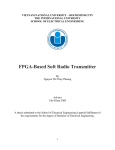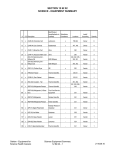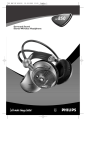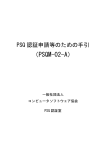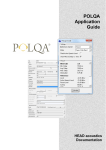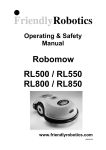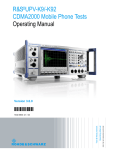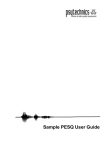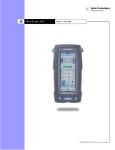Download TCA 4100 Telephony Conformance Analyzer
Transcript
Wi-Fi VoIP PESQ DECT Analog Bluetooth Cellular TCA 4100 Telephony Conformance Analyzer VQT (PESQ) Acoustics and voice quality conformance testing for mobile, wireline and wireless phones Experts In GLOBAL COMPLIANCE SOLUTIONS TEST WHAT YOU HEAR Solutions Features Applications •Cellular phones •Compliance testing •Compliance testing •VoIP phones (SIP and H.323) •Wi-Fi handsets •Soft phones •DECT phones •Bluetooth hands-free and headsets •USB phones and adapters •Analog telephones •Cordless telephones according to major world standards •Fully automated testing & documentation •Built-in standards and general-purpose tests •Supports signaling and remote EUT control •User defined tests, test suites and projects •Audio devices •Manual operation for development and debugging testing •MP3 and CD players •Comprehensive online help •Hearing aids •Powerful management, display and analysis features •Modular design – tailored to your needs •R&D testing •QA testing •Production testing TCA 4100 Telephony CONFORMANCE ANALYZER Key Standards • TIA/EIA-810-A/B • TIA/EIA-920/A • TBR 10 • ETSI ES 202 737-740 • 3GPP ETSI TS 26.131, 26.132 • 3GPP TS 51.010-1 (GSM 11.10) • 3GPP2 C.S0056-0 • ETSI EN 300 903 (GSM 03.50) • ITU-T P.342, P.360 • ETSI TS 102.027 / RFC 3261 • PESQ: ITU-T P.862, P.862.1 • And more Acoustics and voice quality conformance testing for cellular, digital, and analog phones The TCA 4100 provides a fully automated & affordable voice quality and acoustics conformance test solution according to major worldwide standards. This highly integrated test system provides the hardware and software required for testing almost any type of wire-line and wireless phones, electroacoustic and audio devices. The system can be optionally configured with a VoIP software interface, analog PSTN interface, cellular RF base station simulator, wireless DECT, Wi-Fi base stations, Bluetooth wireless interface and 4 HL TCA 4100 TELEPHONY CONFORMANCE ANALYZER acoustic interfaces such as HATS (Head and Torso Simulator) or a test head. The interfaces are calibrated together and automatically controlled by the system software. Designed for R&D, test labs and high-speed production testing, the TCA 4100 powerful management and automation features simplify and shorten the testing cycle. Fully automated testing TCA 4100 comes with test suites ready for testing according to the supported standards. Tests can be performed automatically, either one by one or in a sequence. No user interaction is required except for the setting of Equipment Under Test (EUT) in response to prompts appearing on the screen. Completely unattended testing is possible for equipment that can be remotely controlled by signaling or ASCII commands. Programmable signaling procedures allow call establishment with the EUT during tests and measurements. The EUT can also be controlled by programmable ASCII commands over the LAN, USB, Serial or GPIB interfaces. Such functionality together with the capability to define custom tests and test sequences is especially useful for production testing. Reports are automatically generated in Microsoft Word format providing test results and all information required for a test project. Deciding what standard’s tests are applicable for a particular product can sometimes become a complicated task. Predefined and user-defined criteria for quick selection of the required tests simplify this task. The tests are automatically selected by answering Yes/No questions about the functionality supported by the product. Tests can also be manually selected. A test can be automatically repeated with different (or identical) sets of test parameters and limits. TCA 4100 comes with pre-defined test suites, according to the supported standards. 5 HL TCA 4100 TELEPHONY CONFORMANCE ANALYZER Create a test project from multiple standard suites Select the required tests based on the product features Run the tests automatically Date of Issue: 6/15/2009 Test specification: 5.2.2 Send loudness rating (SLR) Test purpose: To verify the send loudness rating (SLR) as the conversion ratio of a defined acoustic signal at the mouth reference point (MRP) to the transmit signal at the Point of Interconnection (POI). The SLR calculates according to ITU-T Recommendation P.79. The nominal values of SLR to the POI shall be 8 +/- 3 dB. Test mode: Compliance Date & Time: 6/15/2009 5:37:07 PM Temperature: 25 °C Air Pressure: 1014 hPa PASS Verdict: Relative Humidity: 48 % Mains Power Supply: 230 VAC, 50 Hz Remarks: CellPhone 2556 Generate MS Word reports for multiple standards Measurement uncertainty Expanded Uncertainty, k=2 (95% confidence) Sensitivity = ±0.65 dB Voltage vs time, conditions 1 to 2 Voltage (V) Complete testing and documentation required by standards and regulatory agencies in a matter of hours Time (s) –––– Result - Condition 1: Stimulus file: [SOUNDS]male.wav –––– Result - Condition 2: Stimulus file: [SOUNDS]harvardman.wav Loudness rating Send loudness rating (SLR) Limit min Limit max 5 dB 11 dB 5 dB 11 dB Condition 1: Stimulus file: [SOUNDS]male.wav 8.83 dB 9.38 dB Project: 14316, Native Codes Ltd., CellPhone 2556 6 HL TCA 4100 TELEPHONY CONFORMANCE ANALYZER Verdict Pass Condition 2: Stimulus file: [SOUNDS]harvardman.wav Pass Pass Pass Page 11 of 72 Page 1 of 1 Manual operation Powerful display & analysis Test results are continuously displayed on graphs and tables, together with the current test status and verdict, key test parameters, user prompts, the current test point and measured values. Time and frequency domain measurements with minimum, maximum and average statistics are also provided. For each test, you can set which results will appear on the display and in the test report, set limits, number of plots per graph, style and color of each plot, select Log or Linear axis, set axis scale or select auto-scaling, select which test parameters will appear in the test report, rename test results, add comments and environment conditions description to test results. Measured results can be analyzed by using markers, delta markers, zoom in/out, max/min peak search, scroll and pan graph features. Further analysis is possible by copy/pasting the results to the preinstalled Microsoft Excel. Besides fully automated testing capabilities, the TCA 4100 provides on-the-fly control of test parameters and “manual” tuning and stepping which is important for development and debugging testing. Test execution can be paused/resumed, automatically swept or manually stepped through multiple test ranges. A test can run once or continuously at single or multiple test points (e.g. frequency). Benefit from real-time measurements and display in R&D applications 7 HL TCA 4100 TELEPHONY CONFORMANCE ANALYZER Next generation testing Test execution paused/ resumed, automatically swept or manually stepped/ tuned or run continuously at single or multiple test points (e.g. frequency) Tests repeated for multiple settings/configurations Current results, user prompts and overall test verdict displayed continuously Multiple result plots with user-defined colors and styles displayed on a single or split screen in Time, Frequency, Amplitude and Phase domains User-defined limit lines and masks Linear or Log X and Y axis Multiple numeric and status results with limits and verdicts displayed in a table On-the-fly control of test parameters for debugging and development testing Measured results analyzed with zoom, peak search and markers Programmable signaling and remote EUT control for fully automated testing User annotations and automatic Time & Date stamp 8 HL TCA 4100 TELEPHONY CONFORMANCE ANALYZER 9 HL TCA 4100 TELEPHONY CONFORMANCE ANALYZER Lab in a box TCA 4100 is not just a test instrument. It is also a highly integrated system of tools & features for performing and supporting tasks required in a test lab such as: • Definition and management of test specs and test plans with customized user prompts, remote EUT control commands and automatic test selection criteria. • Running and management of test projects. • Generation and management of test reports. • Integral client information database linked to test projects. • Integral database of network signals, simulations and signaling that can be used in tests. • Built-in calibration tests. • Backup and restoration of all data as well as restoration of factory data. • Emergency recovery of all software and factory data from an image disk supplied with the system. • Quality Assurance issues have been thoroughly addressed: »» ISO/IEC 17025 compliant test reports. »» Tests, test suites, projects, and reports are uniquely identified. »» Changes to test definitions are recorded. »» TCA 4100 comes with calibration according to ISO/IEC 17025. 1. Setting results format Versatility and ease of use The TCA 4100 features the familiar Windows user interface. Test suites, test projects, tests, reports and other data and tools are presented in Windows Explorer-like tree/list views. Intuitive commands such as Open, New, Delete, Save, Find, Properties, and data operations are implemented through double-click, menus, toolbar icons, and right mouse button contextsensitive pop-up menus. 10 HL TCA 4100 TELEPHONY CONFORMANCE ANALYZER 2. Setting limits In addition to thousands of built-in tests, users can easily create new custom tests by setting the results format, test parameters, ranges, limits, EUT remote control commands, user prompts and test execution sequence. No programming or scripting is required. Both system and user tests are grouped in test suites. New test suites for new standards or user specifications can be created. Test suites are used to access, set and run tests, and serve as templates for new suites and projects. A project provides the tools to run and manage tests and store & document test results. A project is created from one or multiple test suites, inheriting all their definitions. It contains all necessary information required for a test project: 3. Setting test ranges 4. Setting test parameters • Details of the product under test. • Client details. • Project performance information. • Test specification - group of test definitions, created from one or more test suites. You can modify the test specification in the project and save the project test specification as a test suite, to be used as a template in other projects and suites. • Project and tests status including the verdict. • Test results are saved for each test execution in the project. You can: »» Select which results will be included in the test report. »» Generate test reports in Microsoft Word format for each test suite included in the project. »» Open, print and delete test reports from the project. »» Include Microsoft Word documents in a test suite or in a project to document unsupported tests or to include additional information in a test report. 11 HL TCA 4100 TELEPHONY CONFORMANCE ANALYZER On-line help and support TCA 4100 features a comprehensive context-sensitive online help with examples and step-by-step guidance. Professional on-line tech support and training for both novice and advanced users The tests are thoroughly documented with EUT connection and configuration instructions, test specification and measurement uncertainty data. TCA 4100 user interface accommodates the needs of both novice and advanced users. Step-by-step wizards are provided together with straightforward shortcut operations. Remote configuration, user guidance and training can be provided over the internet via remote operation of the TCA 4100. Hermon Laboratories customer support is comprised of a professional team of engineers knowledgeable about the equipment operation and standards. Low cost of ownership TCA 4100 comes with a price significantly lower than the total cost of equipment and systems it can replace such as: a digital oscilloscope, spectrum and network analyzers, digital transmission and jitter analyzer, 12 HL TCA 4100 TELEPHONY CONFORMANCE ANALYZER line and cable simulators, power supplies, protocol, frame, signaling analyzers, various test bridges and a PC. Achieving automation requires further investment in integration and software development or buying expensive third-party solutions. Modular design and upgradeability TCA 4100 offers a modular design enabling you to buy only what you need. You then have the flexibility to upgrade the instrument later for additional options. Testing capabilities are easily extended to cover new standards by defining new user test suites using the GUI or by obtaining updates from Hermon Laboratories. High Accuracy TCA 4100 achieves and even surpasses the accuracy required by the supported standards through careful hardware & software design, testing automation, and by taking into consideration various signal path factors, and automatic selfcalibration & extensive calibration procedures. Signaling TCA 4100 built-in Signaling provides a powerful set of tools found in standalone network, line and switch simulators. It allows you to perform simulation and analysis of various analog and VoIP signals, conditions and messages that are used in telecom networks. Signaling can be used for two purposes: 1.Functional testing of different analog, VoIP signaling features at various network conditions with built-in pass/fail criteria, timing and signal measurements. 2. Establishing a voice communication path with the EUT before performing various tests (e.g. TCA 4100 can originate a call between a PBX line and VoIP extension and then perform an intermodulation distortion test between these two ports). Different networks, switches and CEs (Customer Equipment) can be simulated by programmable network conditions and call scenarios. Sequences of test cases with transmitted and expected (received) signals and messages, delays, timeouts, IF/THEN/GOTO cases, remote EUT control and pass/fail criteria can be defined. A database of pre-defined signals, messages, and signaling sequences used in multiple countries is provided. 13 HL TCA 4100 TELEPHONY CONFORMANCE ANALYZER Acoustic and Telephonometry Testing Supported Equipment Handsets, Headsets and Hands-free phones such as: • Cellular phones (GSM, CDMA, WCDMA, CDMA 2000) • VoIP phones (SIP and H.323) • Wi-Fi handsets • Soft phones • DECT phones • Bluetooth hands-free and headsets • USB phones and adapters • Analog telephones • Cordless telephones • Hearing aids • Audio devices Acoustic tests are performed to assess electro-acoustic performance, speech quality of phones and to verify compatibility with other phones and communication networks. Various characteristics of a phone are tested over its electro-acoustic path between the phone’s interface, microphone, speaker and line (wired or wireless). Handset phones are placed in HATS (Head And Torso Simulator) or in a test head which provides the reference standard positions from the built-in ear and mouth simulators. The ear and mouth simulators are connected to the TCA 4100 internal input preamplifier and output power amplifier. 14 HL TCA 4100 TELEPHONY CONFORMANCE ANALYZER Hands-free phones should be tested in a quiet environment such as an anechoic chamber with a test head that has a hands-free positioner or with HATS (depending on the standards). Tests are performed according to procedures and specifications defined in ITU-T, ETSI, TIA and other standards. User-defined tests can also be performed. Coupled with other testing capabilities such as signaling functional testing and simulation, SIP (VoIP) protocol conformance testing, the TCA 4100 is a comprehensive tool for conformance, R&D, QA and production testing of phones. Voice Quality Testing (PESQ) Voice Quality Testing (VQT) utilizes PESQ (Perceptual Evaluation of Speech Quality) algorithm to assess the voice quality of telecom equipment and networks. The PESQ algorithm, defined in the ITU-T P.862 recommendation, models human perception of speech, by comparing a reference speech signal with the “degraded” signal. The reference signal is transmitted by the test instrument to the EUT (Equipment Under Test) and the degraded signal, output by the EUT is measured by the test instrument. The most important result is the ITU-T P.862 PESQ MOS (Mean Opinion Score), because it directly expresses the voice quality. The PESQ MOS ranges from 1.0 (worst) up to 4.5 (best). Additional results such as Delay and Delay Jitter, G.107 rating R factor, various waveforms, level, gain, loudness, SNR, VAD (Voice Activity Detection) parameters Front End Clipping, Hold Over Time and Drop outs are also provided. Of particular interest is speech quality assessment and analysis of compression and VAD codec’s such as those utilized in VoIP and wireless networks. The VQT measurements can be performed between any two TCA 4100 interfaces (e.g. between acoustic and VoIP interface). The analysis can be performed on-line and off-line (comparison of pre-recorded files). Received voice signals can be recorded to wav files. Voice Quality Testing (TOSQA) Key features • PESQ MOS per ITU-T P.862 • Codec VAD testing • Delay and Delay jitter • Fully automatic measurements with built-in signaling • Automatic reading/recording from/to one or auto-incremented files • On-line and off-line analysis • Real-time display of results and degraded versus reference waveforms TOSQA (Telecommunication objective speech quality assessment) is an intrusive objective voice quality measurement method developed by Deutsche Telekom. TOSQA supports only narrowband electrical recording while TOSQA2001 adds wideband and acoustic recording support. Similar to PESQ this method uses pre-recorded files that are transmitted to EUT input, recorded on EUT output and then compared. Primary outputs of this method are TOSQA value (0 to 100, more is better) and TMOS (1 to 5, more is better) according to ITU-T recommendation P.800. Another quality parameter provided by TOSQA is the estimated Equipment Impairment Factor IE for E-Model according to the ITU-T G.107 recommendation. PESQ VQT can replace an array of lengthy “traditional” TIMS voice frequency measurements. PESQ evolved from the need to automate the human listening tests (as defined in ITU P.800) and has introduced improvements to the older PSQM+, PSQM and PAMS methods. 15 HL TCA 4100 TELEPHONY CONFORMANCE ANALYZER Cellular phone testing Standards • GSM • CDMA • UMTS • WCDMA • CDMA 2000 Standards • 3GPP ETSI TS 26.131 • 3GPP ETSI TS 26.132 • 3GPP TS 51.010-1 (GSM 11.10) • 3GPP2 C.S0056-0 • ETSI EN 300 903 (GSM 03.50) • ITU-T P.342, P.360 16 TCA 4100 cellular testing options include an Agilent 8960 Series 10 Wireless Communications Test Set that connects to the TCA 4100 audio interface, providing a radio link with the cellular phone under test. All current cellular technologies such as GSM, CDMA, WCDMA and CDMA2000 are supported with the Agilent 8960 options. HL TCA 4100 TELEPHONY CONFORMANCE ANALYZER Agilent 8960 can be configured and controlled by the TCA 4100 software enabling fully automatic testing. Built-in test suites according to main 3GPP, ETSI and ITU-T standards are provided with the cellular options. VoIP phone testing Audio testing Testing of VoIP enabled phones is fully covered by TCA 4100 Acoustic, Voice quality, Functional and Protocol testing. Audio devices such as MP3 players, CD/DVD players, amplifiers, speakers, microphones and sound cards can be characterized with built-in tests such as Level, Wi-Fi handsets, Soft phones, USB Frequency response, Gain, THD+N, and Bluetooth phones can be tested Phase, Jitter, Crosstalk and SNR. with various TCA 4100 options. SIP Protocol Conformance testing SIP Conformance Analyzer is an advanced testing solution for SIP enabled products widely used in today’s VoIP and 3G networks. Comprehensive tests, protocol simulation and analysis tools verify SIP compliance according to ETSI TS 102 027 / RFC 3261 ensuring high probability of interoperability. Offering a full suite of over 600 test cases, the SIP Conformance Analyzer is an automatic conformance testing solution that significantly reduces testing time and facilitates problem identification and debugging. SIP Conformance Analyzer is provided as an option for the TCA 4100. Analog phones testing The analog telephone test option (opt. ALG) provides a comprehensive solution for electro-acoustic, Telephonometry, voice quality and functional testing of analog telephones. Built-in variable complex terminations, artificial lines, series resistance, loop feed DC voltage, on-hook, off-hook, progress tones, DTMF, rings together with the other signaling features allow for the simulation of various analog telephone networks. Audio quality testing PEAQ (Perceptual Evaluation of Audio Quality) provides accurate and repeatable estimates of audio quality degradation occurring through e.g. coding procedures. It compares the audio signal input to a device under test (DUT) with the corresponding (degraded) audio signal output from that device on a perceptual basis. SIP Conformance Analyzer Features • Fully automatic testing of SIP protocol (RFC 3261) according to ETSI TS 102-027 • TTCN-3 suites for User Agent, Proxy, Redirect server, Registrar • Tests for valid, invalid and inopportune SIP protocol behavior and syntax variations • User-friendly test parameter (PICS/ PIXIT values) setting • User-configurable tests suites • On-line and off-line analysis • Real time display of protocol traces and test results • Logging of trace and results to file • Automatic test reports in text and MS Word format Widely used for active testing in lab environments, PEAQ measurement has achieved a great reputation for its ease of use and reliability of results while avoiding the costs for expensive and time consuming listening tests. PEAQ is fully compliant to ITU-R BS.1387 covering the applicability to high quality audio signals with sampling frequencies of 44.1-48kHz. SIP Conformance Analyzer 17 HL TCA 4100 TELEPHONY CONFORMANCE ANALYZER TCA 4100 test configuration examples Bluetooth headset testing DECT telephone testing VoIP EUT Wi-Fi handset testing USB voice EUT Opt. Bluetooth Opt. DECT USB LAN USB LAN Opt. WiFi LAN USB USB-GPIB controller Hands-Free testing Mobile phone testing Opt. Hands-free Hearing Aid Compatibility testing Cellular base station simulator (Cellular options) Analog telephone testing Opt. HAC – Magnetic field antennas Test head (opt. ACU) 18 HL TCA 4100 TELEPHONY CONFORMANCE ANALYZER Head and Torso Simulator (opt. HATS / HATS2) 19 HL TCA 4100 TELEPHONY CONFORMANCE ANALYZER SPECIFICATIONS Supported standards1,4 Acoustic and telephonometry testing of handset and hands-free telephones (opt. ACU, HATS, HATS2) VoIP and Digital telephones (opt. VoIP, DECT, WiFI, Bluetooth) TIA/EIA-810-A 3 TIA/EIA-810-B TIA/EIA-920 3 TIA/EIA-920-A TBR 10 3 ETSI ES 202 737 3 ETSI ES 202 738 3 ETSI ES 202 739 3 ETSI ES 202 740 3 EN 50332 3 Cellular telephones 3GPP TS 26.131, 3GPP TS 26.132 3GPP TS 51.010-1 (GSM 11.10) ETSI EN 300 903 (GSM 03.50) ITU-T P.342, P.360 3GPP2 C.S0056-0 (cdma 2000) TIA-1042-2005.11 (cdma 2000) EN 50332 3 Analog telephones TBR-38 ANSI/TIA-470.110-C ANSI/TIA-470.120-C EN 50332 3 Hearing Aid Compatibility (opt. HAC) FCC 68.316 and 68.317 HAC (USA) SIP protocol testing (opt. SIP) ETSI TS 102.027 / RFC 3261 Voice Quality Testing (opt. VQT) ITU-T P.862, P.862.1 (International) PEAQ – Perceptual Evaluation of Audio Quality (opt. PEAQ) ITU-R BS.1387-1 Notes: 1. Excluding: High voltage (surges, overvoltage protection, leakage current), EMC, safety, environmental tests 2. Contact Hermon Laboratories for other available standards 3. Some standards are optional - please consult with Hermon Laboratories 4. Requires opt. TSYNC 20 HL TCA 4100 TELEPHONY CONFORMANCE ANALYZER Main tests Acoustics and Telephonometry Sending and Receiving Sensitivity/ frequency response Sending and Receiving Loudness Rating (SLR, ROLR, RLR) Receive Volume Control Sending and Receiving Linearity Sending and Receiving Distortion Sending and Receiving Noise Sidetone and Sidetone Masking Rating (STMR) Sidetone delay Sending and Receiving Delay Spectrum Analysis with stimulus Hearing Aid Compatibility Magnetic field intensity Induced voltage frequency response Hearing aid compatibility volume control Voice over IP Acoustics and telephonometry tests of handset and handsfree VoIP terminals (see Acoustics and Telephonometry) Voice Quality Testing (See Voice Quality Testing) VoIP spectrum analysis and signal generation VoIP signaling analysis Call simulation and analysis of SIP and H.323 Programmable Call, Answer, Disconnect Playback and recording of .wav files SIP protocol conformance testing Conformance testing of SIP - Session Initiation Protocol (defined in RFC 3261) over 10 / 100 Base-T Ethernet interface per ETSI TS 102 027. Audio and Voice Frequency Testing Single port (referenced to pre-recorded signals e.g. on MP3 players) and dual port measurements over the following transmit – receive ports: audio, analog (FXS), acoustic (mouth or ear simulator), VoIP Including: Level Voice Quality Testing PESQ (Perceptual Evaluation of Speech Quality) testing over a combination of the following TCA transmit – receive ports: Sound Pressure Level (SPL) Instability and Howling Echo return loss Terminal weighted coupling loss single talk & double talk (TCLwst & TCLwdt) Acoustic shock protection Ambient Noise Rejection Voice Quality Testing of handset and hands-free terminals (see Voice Quality Testing) Programmable received event masks and if / then / go to conditions for flow control of the simulation execution and verdict setting Programmable user messages, user verdicts and remote commands (for EUT automatic operation) Pre-defined and user defined database of signals and encodings Through transmission tests 2 analog (FXS), acoustic (mouth or ear simulator), VoIP with on-line analysis and recording to . wav file(s) Frequency Response THD+N Phase 4 Crosstalk Signal-to-Noise Ratio Jitter 4 Off-line analysis of degraded vs reference .wav files Including the following measurements: PESQ MOS per ITU-T P.862 and MOS LQO per ITU-T P.862.1 Attenuation, Loudness AGC measurements Delay and delay jitter VAD (Voice Activity Detection) performance analysis: Reference and degraded signal level and loudness with aligned and non-aligned waveforms Front End Clipping, Hold Over Time (Hang Over Time) Speech dropout R factor (ITU-T G.107 e-model) Audio Quality Testing 4 PEAQ (Perceptual Evaluation of Audio Quality) testing over the TCA audio interface including the following measurements: Objective Difference Grade (ODG) Distortion Index (DI) TOSQA TOSQA (Telecommunication Objective Speech Quality Assessment) testing Modulation changes, loudness of distortions, Linear distortions, Bandwidths of Signals, Frequency of audible distortions, Noise-to-mask ratio, Detection probability, Harmonic structure of error According to TOSQA (electrical measurement) and TOSQA 2001 (acoustic and electrical measurements) over a combination of the following TCA transmit – receive ports: analog (FXS), acoustic (mouth or ear simulator), VoIP with on-line analysis and recording to . wav file(s) Off-line analysis of degraded vs reference .wav files Including the following measurements: TOSQA value TMOS value Equipment Impairment Factor Ie Delay 21 HL TCA 4100 TELEPHONY CONFORMANCE ANALYZER Test Interfaces Analog PSTN interface (opt. ALG) PC interfaces One Analog 2-wire FXS test port with Off-hook LED indicator SVGA output Connectors ....................................... Two 4 mm banana jacks Output loop feed voltage .................... 48 Vdc Maximum loop current....................... 120 mA Series resistance................................ 400 – 10 k with 10 steps Parallel Termination........................................ 600 , 900 , 270 + 750 || 0.15uF, 82 + 600 || 0.068uF, 220 + 820 || 0.115uF, 370 + 620 || 0.31uF Ethernet LAN Artificial line........................................ 0, 2.7 km, 4.6 km (Per ANSI/TIA-470.100C 4.3.6) CPE load simulator.............................. According to ANSI/TIA-470.100C 4.3.7 Audio interface Connector..................................... BNC female Impedance................................... 1 Maximum output voltage.............. 14 Vpp Frequency range.......................... 10 Hz – 20 kHz Measurement input Connector..................................... BNC female Impedance................................... 100 k Maximum input voltage................ 2 Vrms Frequency range.......................... 10 Hz – 24 kHz Acoustic interface LEMO type female (2-pin) Connects to external mouth simulator / speaker LEMO type female (7-pin) Connects to external ear simulator (right ear) / microphone Second measurement input Connector.................................... -USB 2.0 compatible Connector type............................ Connector type............................ Eight standard USB ports DB25 female 10/100 Mbit/s NIC....................... Two ports Connector type............................ RJ-45 female Audio output, Line input, Microphone input Audio interfaces. AC ‘97 Audio Codec compatible Connector types........................... Keyboard 3.5 mm stereo jacks -Connects to external keyboard Connector type............................ PS/2 female -Connects to external mouse Connector type............................ PS/2 female Built-in PC Intel Core 2 Duo CPU 1 GB RAM Internal 160 GB hard disk General Power requirements 100 – 240 V AC rms, 50 Hz / 60 Hz, 3A(@ 100 V) 1.5A (@ 240 V) , 460 W maximum with all options installed and including the external monitor Temperature Operating .............................................. Storage................................................... LEMO type female (7-pin) Connects to external ear simulator (left ear) / microphone Operating................................................. Storage..................................................... LEMO type female (7-pin) Connects to external ear simulator microphone VoIP Ethernet test interface (opt. VoIP) Operating.................................................. Storage..................................................... Signaling protocols SIP, H.323 Codecs G.711, G.722, G.726, G.723, G.729A, GSM FR, iLBC2 22 HL TCA 4100 TELEPHONY CONFORMANCE ANALYZER up to 10,000 feet (3,048 meters) up to 31,500 feet (9,600 meters) Regulatory Compliance EMC.......................................................... Safety....................................................... (One of the Ethernet LAN ports. See below) 30% to 80% 10% to 85% Altitude Low-sensitivity measurement input Connector.................................... 5° C to 35° C -10° C to 60° C Relative Humidity Measurement input Connector.................................... HD15 female Environmental Conditions Audio frequency generator output Connector.................................... USB Mouse Audio frequency generator output -Connects to external monitor supplied with the system Connector type............................ EN 61326 FCC Part 15, Class A IEC/EN/UL 61010-1 Dimensions 483 mm (W) x 133 mm (H) x 400 mm (D) Without accessories Weight 15 kg with all the options installed without external accessories Ordering information TCA 4100 Telephony Conformance Analyzer Includes instrument mainframe with operating software, MS Windows XP Professional OS, MS Office Basic factory installed, and on-line User Manual. At least one of the following options must be ordered. Opt. ALG For connection of analog terminal equipment. Used in acoustic and Voice Quality testing. Opt. ACU Acoustic and Telephonometry testing. Includes external test head for handset fixation with ear simulator and mouth simulator. Opt. HATS Acoustic and Telephonometry testing. Includes Head and Torso Simulator (HATS) with built-in mouth simulator, ear simulator (right ear) and handset positioner. For handset, headset and hands-free devices testing. Opt. HATS2 Same as Opt. HATS plus left ear simulator. Opt. HAC Hearing aid compatibility test option. Includes two magnetic field antennas, interconnecting cable. Opt. TSYNC Includes hardware and software for dual-port time-synchronized measurements such as phase, jitter and PEAQ. Opt. ANR Includes 4-port audio card and four external speakers for Ambient Noise Rejection test. Opt. PESQ PESQ voice quality testing. ITU-T P.862 (MOS). Opt. TOSQA TOSQA voice quality testing. Opt. SIP SIP protocol testing over 10 / 100 Base-T Ethernet interface per ETSI TS 102 027 / RFC 3261. Opt. DECT DECT interface for acoustic and telephonometry testing of wireless DECT handsets. Includes external DECT base station that connects to the Analog PSTN interface. Opt. WiFi Wi Fi interface for acoustic and telephonometry testing of wireless Wi Fi handsets. Includes external Wi Fi base station that connects to the Ethernet port. Opt. Bluetooth Bluetooth interface for acoustic testing of Bluetooth headsets and hands-free sets. Includes external USB Bluetooth adapter. Cellular options Acoustic and telephonometry testing of (GSM, CDMA, WCDMA, CDMA2000) cellular telephones. Includes external cellular base station simulator. Consult with Hermon Laboratories on the cellular interface specification. Options ALG and Bluetooth must be factory installed. All the options can be installed together. Recommended accessories External 17” or 19” LCD color monitor External keyboard and mouse External USB DVD RW For backup/restore and emergency software and factory data recovery External USB to GPIB controller For control of external GPIB test equipment 23 HL TCA 4100 TELEPHONY CONFORMANCE ANALYZER Bluetooth Cellular PESQ Wi-Fi VoIP DECT Analog Since 1986 Hermon Laboratories TI Ltd HaTachana St., P.O.Box 23, Binyamina 30550 Israel Tel: +972-4-6268450 Fax: +972-4-6268498 Email: [email protected] www.hermonlabs.com Local representatives and sales offices are located throughout the world. To find the most convenient one visit www.hermonlabs.com Copyright 2009 Hermon Laboratories TI Ltd. All rights reserved. Product specifications and descriptions in this document are subject to change without notice. Product and brand names are trademarks of their respective owners. Head and Torso Simulator (HATS) presentations are courtesy of Brüel & Kjær Sound & Vibration Measurement A/S. Cellular base station simulator presentation is courtesy of Agilent Technologies, Inc. P/N: 410001903-A2






















